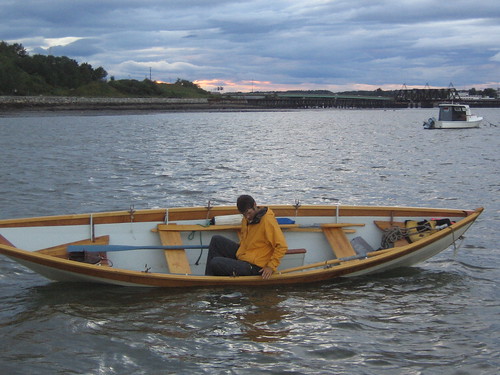
Do you like the idea of a boat that can row and sail but they often don't like the idea of compromising on one or the other? It is a trade-off. A good sailboat's lines are not good for rowing and a rowboat's lines are not good for sailing. The latter is true mainly because the hull is quite narrow and fine on the waterline, especially at the ends. A fast rowboat's lines just don't provide the stability, often, for sailing and the addition of a slot for the board introduces drag and makes the boat slow for rowing. Wooden Boat's long time manager of their boathouse often cites the Joel White Shearwater as an example. Reluctantly, listening to customer demand, Joel White added the centerboard and it really made a difference in the sailing ability: it made it possible. But it also introduced noticeable drag when rowing: the boat was slower under oars. Drake is very similar to Shearwater, only narrower and longer on the waterline, no daggerboard, and therefore faster under oars. Drake sails downwind fabulously because of the moderate keel to provide some lateral resistance and enable excellent tracking for rowing. We don't have a centerboard, so there is no drag induced (though a tight fitting plug for a daggerboard trunk can fair the slot to the hull reasonably well). I've been asked a number of times, and I just will not add a daggerboard to Drake. She is just a blast to sail downwind and can sail as high as a beam reach quite fast. The sail adds tremendous range when you consider the sail as auxiliary power.
But if you want to sail upwind, and row well, you need a boat with a lot of flare in the hull and a shape that provides excellent secondary stability. Joel White's Shearwater and his 18' version of the boat are good examples. Another ideal example is the dory. What I love about the dory is that it is narrow at the waterline and flares out to a generous width, for a rowboat, at the rail, usually 4'8-5'. The Deblois Street Dry is nearly 5' at the rail. The stability this shape produces lends itself to sailing (see photo of me sitting on D St D's gunwale), but the narrow width at the waterline when the boat is not heeled means that it will row well. The double ended shape of the waterline on a dory keeps the ends fine for rowing ability. Drake shows a similar shape (see photo): narrow waterline, 4'1" at the gunwales provides secondary stability.
The Marblehead Gunning Dory is, to me, perhaps the perfect boat. If I could have only one boat (let's not think about that...what a shame that would be!), I would have a gunning dory or a Swampscott Dory. Come to my annual Shop Talk & Messabout to see both of these dory types in the flesh and meet two experts on dories: Sam Manning and Walter Wales.
Thank you to Chris Partridge, blogger in the UK: Rowing for Pleasure for bringing up the subject of rowing vs sailing characteristics in a boat








0 komentar:
Posting Komentar